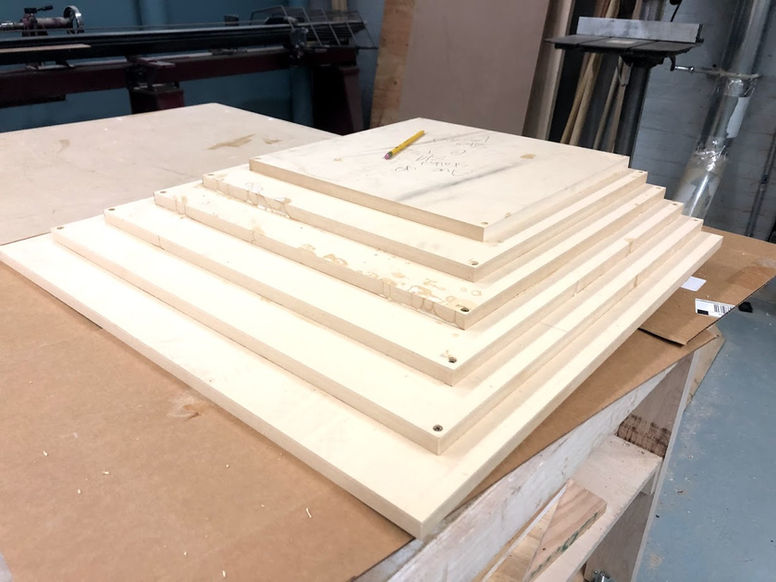5-Axis Workflow
Materials: MDF, Wood Glue
Processes: CAD Design, 3-Axis Router, 5-Axis (3+2) Router
Tools: Fusion 360, MasterCam, MultiCam 8000, MultiCam 5000
About: The goal of this project was to develop a workflow for turning MDF or similar large format sheets and into large objects on a 5-axis router. When you start looking at machining large shapes, material selection quickly becoming a driving factor in the cost of the end product. Furthermore, cycle times can start to grow exponentially if you have large amount of material to remove. For these reasons I wanted to develop a quick and cost-effective 5-axis workflow. This was my introduction to 5-axis, MasterCam, as well as large-scale router work.
Design: I wanted to see what I could get out of a single 8'x4' sheet of MDF. I started with a sketch of these dimensions in Fusion 360, and from there created some parametric rectangles, that diminished in size, to see how many I could fit onto the sheet. I took those shapes and extruded them on top of each other to create a pyramid shape. It started to look like an X-Wing cockpit so I took the design in that direction. I was able to quickly get a model of the 2D contours, the glued up stock as well as the final object to overlay and import them into MasterCam. The CAM was quite straight forward 3-axis contours for the initial shapes and 3+2 programming for the final piece. The 5-axis machining started with an adaptive roughing cycle and finishing with 2D contours, normal to the objects faces. If I was to do it again I would have incorporated some swarf cuts to spice things up.
Machining: I routed out the initial shapes on a MultiCam 5000, including two holes for orientation. From there was the simple task gluing them up. The 5-axis machining was also fairly straightforward with the usual learning curve on new machines. This machine used a very strange controller, including a keyboard featuring Comic Sans keys. The 2D cycle time was orders of magnitude quicker than the 5-axis work. As a result I would spend more time optimizing the 2D shapes to reduce the 5-axis material removal to a minimum. In future trials I will try 3D machining in the 3-axis stage, before the glue-up, to eliminate any roughing cycles.
Conclusion: The final product was heavy! If I were to do it again, I would have included voids on the interior of the piece. It would be interesting to see how thin you could make it, while still keeping structural integrity.
Some post processing would certainly be required on this piece as a result of some less-than-sharp tooling and the nature of MDF. I don't see this as a failure as a piece like this would inevitably get sanded, primed, and pained.




